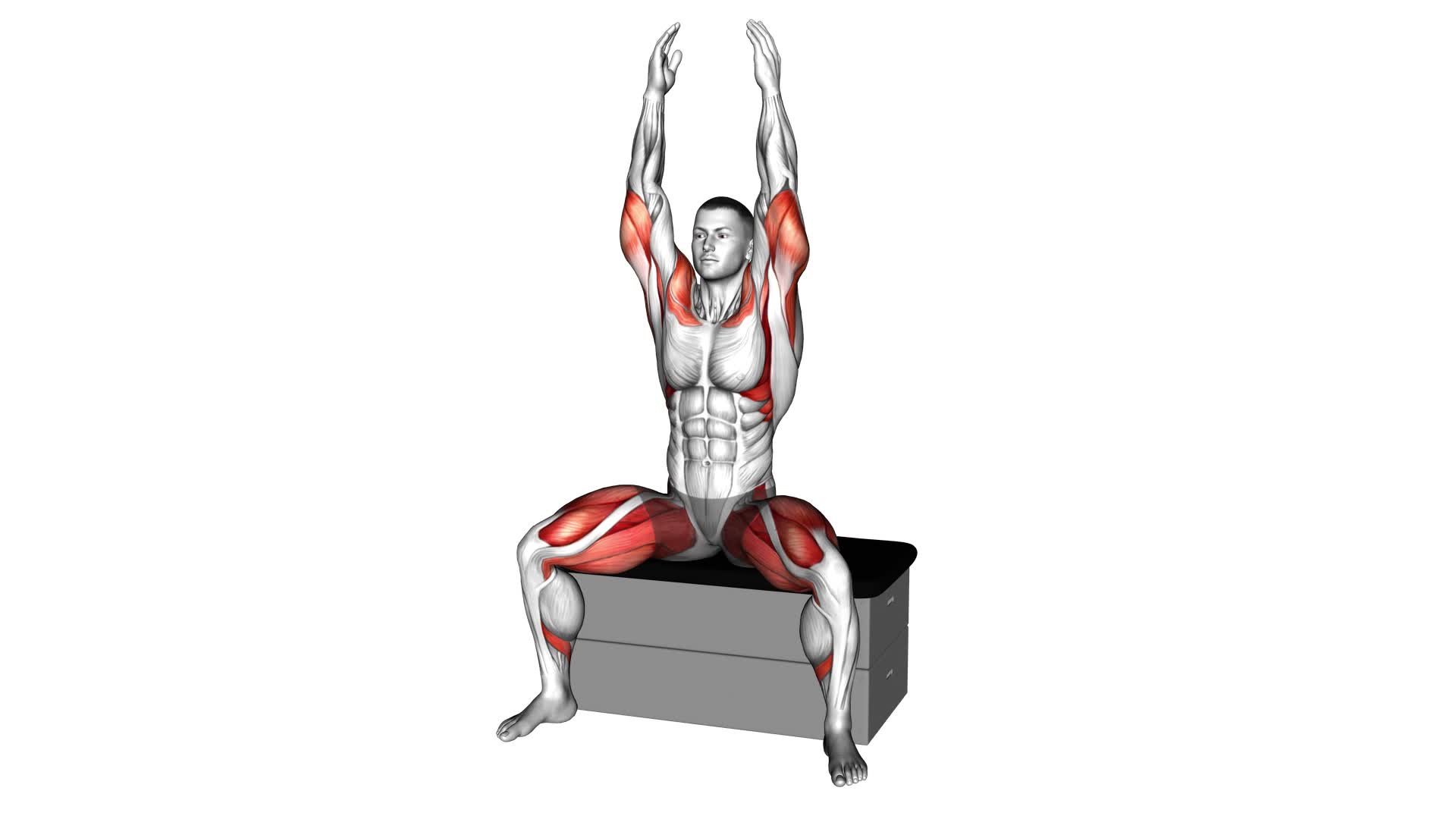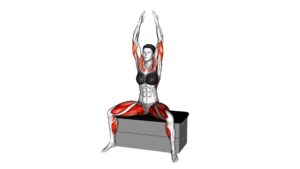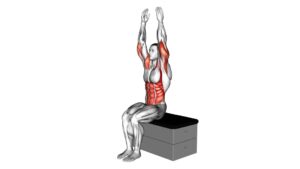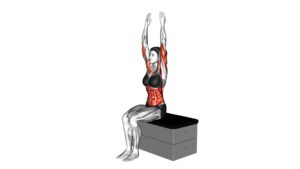Sitting Shoulder Press and Hip Abduction on a Padded Stool – Video Exercise Guide & Tips

Are you looking for a challenging workout that targets your shoulders and hips?
Watch This Exercise Video
Look no further than the Sitting Shoulder Press and Hip Abduction on a Padded Stool.
This exercise guide and video will show you the proper form and technique, as well as modifications for different fitness levels.
Get ready to maximize your workout and achieve your fitness goals with these effective exercises.
Key Takeaways
- Increased upper body strength
- Improved hip stability
- Strengthened shoulders, arms, and upper back
- Enhanced posture
Benefits of the Sitting Shoulder Press and Hip Abduction
The benefits of the Sitting Shoulder Press and Hip Abduction exercise include increased upper body strength and improved hip stability. When performing the Sitting Shoulder Press, you activate several muscles in the upper body, including the deltoids, triceps, and upper back muscles. This exercise helps to strengthen and tone your shoulders, arms, and upper back, leading to improved posture and overall upper body strength.
Hip abduction, on the other hand, primarily targets the hip muscles, including the gluteus medius and minimus. By incorporating hip abduction into your workout routine, you can strengthen these muscles, which are crucial for hip stability and proper movement mechanics. This can help to prevent injuries and improve your overall athletic performance.
To incorporate the Sitting Shoulder Press and Hip Abduction into a full body workout routine, you can start by performing the Sitting Shoulder Press as part of your upper body workout. You can use dumbbells or a barbell, sitting on a padded stool with your feet flat on the floor. Then, after completing your upper body exercises, you can move on to the Hip Abduction exercise, using a resistance band or machine to target the hip muscles.
Equipment Needed for the Exercise
To perform the Sitting Shoulder Press and Hip Abduction exercise, you'll need specific equipment. The main piece of equipment required for this exercise is a padded stool. The padded stool provides a comfortable surface to sit on and supports your body during the exercise. It also helps in maintaining proper form and stability.
Using a padded stool has several benefits. Firstly, it provides cushioning and reduces the risk of discomfort or injury while performing the exercise. Secondly, it allows you to focus on the targeted muscles, which are the shoulders and hips, without straining other parts of your body.
There are variations of the Sitting Shoulder Press and Hip Abduction exercise that can be performed using different equipment. For example, instead of a padded stool, you can use a stability ball or an exercise bench to challenge your balance and engage your core muscles even more. You can also use dumbbells or resistance bands to add resistance and increase the difficulty of the exercise.
Now that you know the equipment needed for the exercise, it's time to learn about the proper form and technique for the shoulder press.
Proper Form and Technique for the Shoulder Press
To perform the shoulder press with proper form and technique, position yourself on the padded stool and prepare to engage your shoulders and core muscles. Here's how to do it correctly:
- Start by sitting upright on the stool with your feet flat on the floor and your knees bent at a 90-degree angle. Hold a dumbbell in each hand, resting them on your shoulders with your palms facing forward.
- Slowly exhale as you press the dumbbells upward, extending your arms fully without locking your elbows. Keep your core engaged and your back straight throughout the movement.
- Inhale as you lower the dumbbells back down to the starting position, maintaining control and avoiding any swinging or jerking motions.
The shoulder press offers several benefits, including:
- Increased shoulder strength and stability.
- Improved upper body muscle definition.
- Enhanced overall upper body strength and power.
However, it's important to be aware of common mistakes to avoid during the shoulder press:
- Using too much weight, which can compromise form and lead to injury.
- Arching the back or leaning backward excessively.
- Failing to engage the core muscles, which can put stress on the lower back.
Proper Form and Technique for the Hip Abduction
To perform a hip abduction with proper form and technique, start by sitting on a padded stool with your back straight and feet flat on the floor.
Place a resistance band around your ankles and slowly push your legs outwards, away from each other, against the resistance.
Avoid common form mistakes such as leaning forward or relying on momentum.
Correct Hip Abduction Technique
Your hip abduction technique can be improved by using proper form and technique. Here are three key tips to help you perform hip abduction exercises correctly and maximize the benefits:
- Start in the right position:
Sit on a padded stool with your back straight and feet flat on the ground. Keep your knees bent at a 90-degree angle and place a resistance band just above your knees.
- Engage your core and glutes:
Before starting the movement, activate your core muscles by pulling your belly button towards your spine. Squeeze your glutes to stabilize your pelvis and maintain proper alignment throughout the exercise.
- Control the movement:
Slowly and steadily, push your knees outwards against the resistance band, keeping your feet firmly planted on the ground. Pause for a moment at the peak of the movement, then return to the starting position with control.
Common Form Mistakes
When performing hip abduction exercises, it's important to be aware of common form mistakes that can hinder proper technique and effectiveness.
One common mistake is using too much momentum to lift the leg outward, rather than relying on the hip muscles to do the work. This not only reduces the effectiveness of the exercise but also increases the risk of injury. To improve, focus on engaging the hip muscles and moving with control throughout the entire range of motion.
Another mistake is allowing the torso to lean forward or backward during the exercise. To correct this, maintain an upright posture and engage the core muscles for stability.
Lastly, avoid lifting the leg too high or too quickly, as this can strain the hip joint. Instead, lift the leg to a comfortable height and maintain a slow and controlled movement.
Benefits of Proper Form
By maintaining proper form and technique for hip abduction exercises, you can experience numerous benefits in your overall strength and stability. Here are the key benefits of performing the hip abduction exercise with proper form and technique:
- Improved hip strength: Engaging the hip muscles correctly during hip abduction exercises helps to strengthen the muscles responsible for stabilizing the hip joint.
- Enhanced lower body stability: Performing the exercise with proper form helps to improve your balance and stability, which can be beneficial for activities that require lower body strength and control.
- Reduced risk of injury: Using the correct form and technique reduces the strain on your hip joints and surrounding muscles, decreasing the risk of injury.
To ensure you're performing hip abduction exercises correctly, avoid common mistakes such as leaning forward, using momentum to lift the leg, or allowing the opposite hip to drop. Additionally, consider modifications such as using resistance bands or adjusting the range of motion to suit your fitness level and needs.
Modifications for Different Fitness Levels
To modify the Sitting Shoulder Press and Hip Abduction on a Padded Stool exercise for different fitness levels, you can make adjustments to the weight and range of motion. There are different modifications and progression options you can consider based on your current fitness level.
For beginners or those with limited upper body strength, it's recommended to start with lighter weights or even no weights at all. This will allow you to focus on mastering the movement and maintaining proper form. As you become more comfortable and gain strength, you can gradually increase the weight to challenge yourself.
In terms of range of motion, if you find it difficult to fully extend your arms overhead during the shoulder press, you can start with a shorter range of motion and gradually work towards the full range. This will help you build strength and flexibility in your shoulders.
For those who are more advanced and looking for a greater challenge, you can increase the weight you use during the exercise. This will help to further strengthen your shoulder muscles and increase the intensity of the workout.
Remember to always listen to your body and work within your own capabilities. It's important to progress gradually and avoid pushing yourself too hard, as this can lead to injury. With consistent practice and proper modifications, you can tailor the Sitting Shoulder Press and Hip Abduction on a Padded Stool exercise to suit your individual fitness level and goals.
Tips for Maximizing Your Workout
To get the most out of your workout, continue building on your progress by incorporating these tips into your routine:
- Focus on compound exercises: Incorporating compound exercises into your workout routine is a great way to maximize your results. These exercises target multiple muscle groups at once, allowing you to burn more calories and build strength more efficiently. Examples of compound exercises include squats, deadlifts, and bench presses.
- Increase the intensity: To maximize your workout efficiency, gradually increase the intensity of your exercises. This can be done by adding more weight, increasing the number of repetitions, or reducing rest time between sets. By challenging your muscles and pushing yourself to your limits, you'll see greater results in less time.
- Prioritize recovery: A common mistake people make is neglecting rest and recovery. To maximize your results, it's important to give your muscles time to repair and grow stronger. Make sure to incorporate rest days into your workout schedule and prioritize proper nutrition and hydration. Additionally, consider incorporating stretching exercises or foam rolling to improve flexibility and reduce muscle soreness.
Frequently Asked Questions
Can This Exercise Help With Improving Posture?
Improving your posture is important for overall health and wellbeing.
The sitting shoulder press and hip abduction exercise can help you achieve better posture. By engaging your core, shoulders, and hips, this exercise strengthens the muscles needed to maintain an upright position.
The benefits of this exercise include improved spinal alignment, increased stability, and reduced risk of back pain. Incorporate this exercise into your routine to see positive changes in your posture over time.
Is It Safe to Perform the Sitting Shoulder Press and Hip Abduction Exercise if I Have a Shoulder Injury?
If you have a shoulder injury, it's important to take precautions when performing the sitting shoulder press and hip abduction exercise. This exercise puts strain on the shoulder joint, which can worsen your injury.
Instead, focus on alternative exercises that target the hips and core without putting stress on your shoulder.
Consult with a healthcare professional or a certified trainer to find the best exercises for your specific condition and to avoid further injury.
How Many Sets and Repetitions Should I Do for Optimal Results?
To get the best results from the sitting shoulder press and hip abduction exercise, it's important to know how many sets and repetitions to do. Start with 2-3 sets of 8-12 reps for each exercise.
As you get stronger, gradually increase the number of sets or reps. You can also try adding resistance by using weights or resistance bands.
Remember to listen to your body and progress at a pace that feels comfortable for you.
Can I Use Dumbbells Instead of a Barbell for the Shoulder Press Exercise?
Yes, you can definitely use dumbbells instead of a barbell for the shoulder press exercise. In fact, using dumbbells allows for a greater range of motion and can help you target specific muscles more effectively.
This can be especially beneficial if you have a shoulder injury, as it allows you to adjust the weight and movement to your comfort level. Just make sure to start with lighter weights and gradually increase as you build strength and confidence.
How Long Should I Rest Between Sets?
When it comes to rest periods between sets, it's important to find the right balance.
Resting for too long can lead to a decrease in the intensity of your workout, while not resting enough can increase the risk of injury and hinder your performance.
The benefits of adequate rest include allowing your muscles to recover and replenish energy stores, reducing fatigue, and improving overall workout quality.
Conclusion
In conclusion, the sitting shoulder press and hip abduction exercise is a great way to strengthen and tone your upper body and lower body muscles. By using proper form and technique, you can maximize the effectiveness of this workout.
Additionally, modifications are available for different fitness levels, allowing everyone to benefit from this exercise.
Remember to follow the tips provided to ensure a safe and efficient workout.
So grab a padded stool and get ready to challenge yourself with this dynamic exercise routine!

Author
Years ago, the spark of my life’s passion ignited in my mind the moment I stepped into the local gym for the first time. The inaugural bead of perspiration, the initial endeavor, the very first surge of endorphins, and a sense of pride that washed over me post-workout marked the beginning of my deep-seated interest in strength sports, fitness, and sports nutrition. This very curiosity blossomed rapidly into a profound fascination, propelling me to earn a Master’s degree in Physical Education from the Academy of Physical Education in Krakow, followed by a Sports Manager diploma from the Jagiellonian University. My journey of growth led me to gain more specialized qualifications, such as being a certified personal trainer with a focus on sports dietetics, a lifeguard, and an instructor for wellness and corrective gymnastics. Theoretical knowledge paired seamlessly with practical experience, reinforcing my belief that the transformation of individuals under my guidance was also a reflection of my personal growth. This belief holds true even today. Each day, I strive to push the boundaries and explore new realms. These realms gently elevate me to greater heights. The unique combination of passion for my field and the continuous quest for growth fuels my drive to break new ground.







